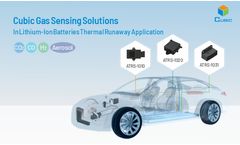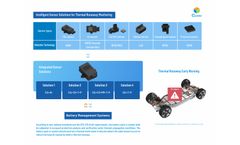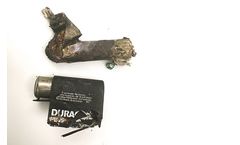battery thermal runaway Articles
-
Cubic Gas Sensing Solutions in Lithium-Ion Batteries Thermal Runaway Application
Recent years, lithium-ion batteries thermal runaway events have attracted widespread attention. To further reduce the loss of life and property caused by lithium-ion batteries thermal runaway, some important regulations have been promulgated. UN GTR 20: “The vehicle shall provide an advance warning indication to allow egress or 5 minutes prior to the presence of a hazardous situation inside ...
-
Cubic Latest Li-battery Thermal Runaway Gas Leakage Detection Solution
Thermal runaway in lithium-ion batteries is a critical concern for safety in electric vehicles. To mitigate the risk of thermal runaway in lithium-ion batteries, it is crucial to proactively implement comprehensive monitoring solution to provide early warning as preventive step against potential harm from lithium-ion battery thermal runaway incidents. As mandated by UN GTR 20 and GB 38031:2020, ...
-
What is Thermal Runaway in Lithium-Ion Batteries?
Thermal runaway is a violent chain reaction of exothermic chemical reactions resulting in an uncontrollable increase in system temperature. Now, where does this reaction might unfold? Batteries and energy storage systems, which are integral parts of tech around us, are the main stage for this drama. They sometimes fall victim to thermal runaway, turning a peaceful power source into a potential ...
-
Major EV Battery Safety Recalls? Electra`s AI Technology Can Help
Electric vehicle recalls have accelerated as the risk of battery thermal runaway due to faults and failures remains a major pain point in the eMobility industry. General Motors recently took a $1.8 billion hit for battery warranty and replacement costs for the Chevrolet Bolt, according to CNBC, and it is not the only major OEM challenged by battery malfunction. While thermal runaway in electric ...
-
Fiber Optic Testing Helps Ensure EV Battery Health and Safety
EVs face unique design challenges in order to be competitive with gasoline-powered vehicles. The root of many of these challenges is in the EV battery pack. Drivers want similar vehicle range per charge when compared to a tank of gas, as well as the convenience they are used to with refilling a tank in just a few minutes. This means battery packs need to be able to store enough energy to go ...
-
Heat Flux Sensing in Battery Monitoring
Batteries are critical devices for many people today: they power smartphones, laptops, and even cars! The wide adoption of batteries was possible because of the invention of the lithium-ion battery (whose inventors won the Nobel Prize this year). If we look at its results, the Li-Ion battery was surely one of the most important engineering achievements of the last 50 years. Given its importance, ...
-
Monitoring Off-Gasses to Guard Against Thermal Runaway Risk with Li-Ion Batteries
Lithium-Ion Batteries Rechargeable lithium-ion (“li-ion”) batteries (comprised of cells in which lithium ions move from a negative electrode through an electrolyte to a positive electrode during discharge—and the other way around when charging) were first described conceptually in the 1970s. Following initial prototype development in the 1980s, li-ion batteries became ...
-
Active prevention of fires caused by damaged batteries during alternative fuel production thanks to Lindner`s Fire Prevention System (FPS)
DI (FH) Thomas Huber & DI Stefan Scheiflinger-Ehrenwerth, MSc. Lindner-Recyclingtech GmbH, Product Management, Spittal an der Drau, Austria Ing. Andreas Säumel Mayer Recycling GmbH, Executive Management, St. Michael, Austria SUMMARY: One of the most pressing recent issues in the mechanical processing and conversion of waste into solid recovered fuels (SRF) is the high fire risk. ...
Need help finding the right suppliers? Try XPRT Sourcing. Let the XPRTs do the work for you






